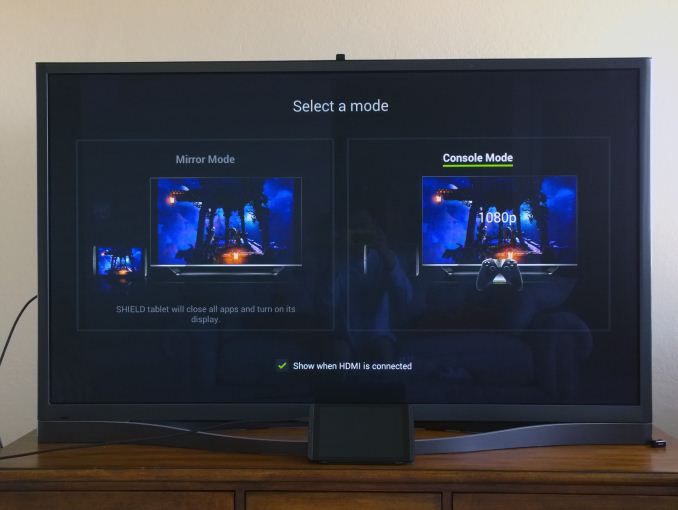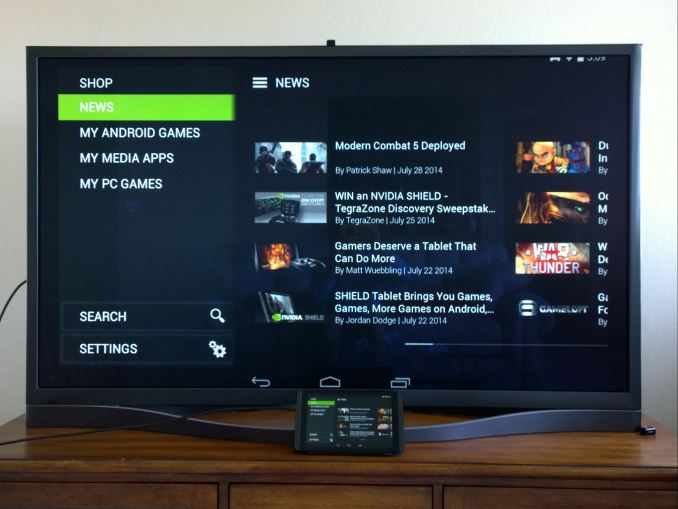The NVIDIA SHIELD Tablet Review
by Joshua Ho on July 29, 2014 9:00 AM ESTSoftware
In the UI department, there’s not too much to talk about. Much like Motorola, NVIDIA has stuck to using the AOSP UI design. Of course, there are plenty of NVIDIA-specific applications, but I didn’t run into any issues using the tablet to do everyday tasks. In this respect, things have improved massively over Shield portable. Because this tablet works in both portrait and landscape, there aren’t any issues with applications that force portrait mode like there were with the Shield portable. In normal tablet usage, it works as one might expect, with no real perceived lag throughout the UI. Of course, this is when compared to other Android devices. There are still frame drops involved in scrolling through lists and similar areas where Android has traditionally struggled to stay smooth, but Android L should fix this issue for the most part.
DirectStylus 2
The real value that the Shield tablet brings as a tablet is the stylus functionality. DirectStylus 2 is definitely much, much better than any other capacitive stylus on the market. The tip allows for precise control and it’s definitely responsive to changes in pressure. For the most part, there are only small issues here. Because the stylus is capacitive, it’s not really possible to have a floating pointer the way Wacom styluses do. In addition, I noticed that I need to lift the stylus a bit more than I might with pencil and paper in order to start a new letter or word or else my words would start to flow together. For the most part though, it works well enough, and the inking latency is low. Unfortunately the issue here is more of ecosystem than hardware, as most stylus-enabled applications aren’t nearly as robust as OneNote on Windows x86.
Console Mode
Of course, the real question here is whether the gaming side is worth the price premium. NVIDIA has gone all out on this area, and their efforts are split up into multiple aspects. The first is the TV interface/console mode, then the gameplay recording feature known as ShadowPlay. Finally, there’s the aspect of GameStream and GRID, which make it possible for games to be played on the tablet that otherwise wouldn’t work due to the compute requirements.
The TV interface effectively boils down to Shield Hub and Google Now, although it’s fully possible to use the full tablet UI as desired in this mode. In the hub, launching games and various applications like YouTube and Netflix is rather simple compared to the more cumbersome full Android UI as they have their own category in Shield Hub. In addition, launching applications through Google Now works as expected. Overall, there aren’t any friction points here. It works as well as one could expect. There is a strong reliance on voice input in general, but it’s much better than trying to type with a controller and better than most smart TV experiences. While the TV interface is mostly targeted towards enabling a console gaming experience, YouTube and Netflix both work great in this mode. NVIDIA has also gone through the necessary DRM certification process to allow for 1080p Netflix streaming. In essence, this device is already ready to serve as an Android TV device.
ShadowPlay
ShadowPlay, which we first saw in GeForce GTX GPUs, is also another major advantage that NVIDIA brings to the table for software experience. In short, this leverages the hardware H.264 video encoder that is on the Tegra K1’s Kepler GPU to provide video capture of gameplay or anything else displayed by the tablet. There are three possible options for video capture. The first is Twitch broadcasting, something that NVIDIA is quite proud of as they are the first to implement such a feature in an Android tablet. While I personally don’t stream on Twitch, a demo of Twitch broadcasting in the initial launch briefing worked without any visible quality issues in either audio or video.
There are two other recording modes. One is a standard start/stop recording feature, but the other is ShadowPlay/Auto Recording. In short, this keeps anywhere from the past minute to 20 minutes in video. This makes it possible to set and forget about the recording feature rather than constantly managing recordings in manual mode. All of these modes can use the tablet’s microphone and front facing camera for commentary purposes as needed. Local recordings seem to have a maximum of 1080p30, and Twitch broadcasts are limited to 720p30.
While those are the technical details, it’s a painless process. All the user has to do is long press the back button on the controller and select what kind of a recording they’d like to do (Twitch, Auto, Manual, Screenshot) and that’s it. I can see significant potential in this area especially if this device takes off as a gaming platform.
















174 Comments
View All Comments
SpartyOn - Tuesday, July 29, 2014 - link
I guess it depends on your setup or what steps you're willing to take. I have an Asus Z77 wifi mobo so I use the Asus Wifi Go app a lot, which allows me remote desktop access and mirroring in an easy package. Haven't invested in a Bluetooth mouse or keyboard, but using USB OTG has worked out just fine for times I've hooked the Shield up to a monitor with M&K.I've done some video editing in Adobe Premiere remotely this way, along with working with Excel files, so I'd say it can actually do work just fine. Does it require some additional cables/accessories to maximize that professional potential? Sure, but then again, I'm not going to be doing any serious work on an 8" Shield tablet without hooking it up to a monitor as well.
fivefeet8 - Tuesday, July 29, 2014 - link
Much of the activities I do require me to be away from the home so a shield with a gamepad attached to the screen would be a bit awkward. The tablet fits more with my requirements.SpartyOn - Tuesday, July 29, 2014 - link
I think there's room for both devices for those that buy into the Nvidia brand and who understand/utilize the gaming features; however, the tablet space is a very competitive market for Nvidia to try and enter, with numerous players, especially for work and professional devices.An additional thought on the gaming side, since this really is the target audience: Does it pass the eye test? If I'm a gamer, and I see someone with a 1st gen Shield, I immediately know that it's a gaming device and might inquire what it is. I also can look at pics when shopping and know that it's a gaming device. If I see someone using the 2nd gen Shield, I just see another tablet out in the wild and when shopping online, it would have to come down to specs/features comparisons.
I guess the overall point I'm trying to make is this: the original Shield was so insanely different that over time it had a chance to succeed, especially with yearly refreshes. Now it's just another tablet that can't even stand up on its own (literally and figuratively) ... how do I balance a tablet in bed or on the couch (or in a plane, train, car?!) when I have to fiddle with a controller and the screen itself. Seems cumbersome for gaming to me and in my opinion actually makes you MORE tethered to a stationary external monitor/HDTV instead of the handheld.
fivefeet8 - Tuesday, July 29, 2014 - link
If there is enough demand for another Shield1 type device, then you may yet see it, but from what's been gathered, there wasn't. Although I do find it also an interesting device, the gamepad agnostic nature of the Tablet gives a better experience with 3rd party pads. Some of which are attachable albeit a bit weight slanted. And it gives console mode an advantage of not having to use another controller.aamir147 - Tuesday, July 29, 2014 - link
I believe the tablet is just another addition to the shield family, this is not to replace the shield portable. This is what the mod in the nvidia blog said.savagemike - Tuesday, July 29, 2014 - link
It would be trivial to make a frame to hold the tablet and controller together for use as you'd like. Meanwhile I was never attracted to the first Shield because gaming is not my number 1 interest - just something that would be a nice bonus.What I'm saying is this more modular approach could easily be made to work as the original Shield but the original Shield cannot be made to work as a stand-alone tablet. So for me this is a much better design.
Especially with the advent of 3d printing. It will only take one clever person to design something to hold the tablet and controller together to mimic the original. If you don't see it pop up soon for easy purchase then it isn't that wanted as it would be simple to do.
Knowname - Wednesday, July 30, 2014 - link
I think you should consider the directstylus modes. I'm sure the wife (if the tablet isn't too heavy) would love that. lus she could read and do other tablet stuffs... if she can get around the horribly dull screen ofc.schizoide - Tuesday, July 29, 2014 - link
You can pick up a refurb Nexus 7 (2013) for $140 from an authorized seller on eBay, or $230 full price and new. The shield tablet costs $300. What do you get for twice the money?From a tablet perspective:
- Slightly larger, but lower quality screen
- Stylus
- Dramatically improved speakers
- 28% heavier
- Maybe slightly snappier? Much faster in benchmarks, but the Nexus 7 2013 is fine for browsing and tablet stuff. I haven't seen anyone compare them in interactive use.
From a gaming perspective:
- Shadowplay, if you have a nVidia GPU in your gaming box and want to plug a tablet into your TV. Better off getting a haswell chromebox and installing steam for linux on it.
- Grid streaming, if you're in northern california.
- A couple Tegrazone games, primarily 10 year old PC ports.
- All the android games built for the lowest common denominator that play on your Aunt's Galaxy S2 will play here too.
In my opinion, the Shield tablet doesn't make a lot of sense as a tablet or as a gaming device. If it was priced competitively with the new Nexus 7, then certainly it would be interesting. If you want to buy a small android tablet and don't care about the $70 (or $160 for the refurb!) I guess go crazy. But will they sell a lot of them? No way.
Now if nVidia could get something like their GTX 860M and crunch it down to fit in a tablet TDP, and slotted it in alongside an atom CPU for a tablet running real Windows, with its massive software library, that could be truly attractive.
ams23 - Tuesday, July 29, 2014 - link
Shield tablet is already #5 in the Amazon.com best sellers list for tablets: http://www.amazon.com/Best-Sellers-Electronics-Com...Nexus 7 is a great tablet too, but the difference in SoC performance is quite large. Shield tablet has 2x higher CPU performance and 3x higher GPU performance in comparison, with a much more modern GPU too.
Note that many of the people getting the Shield tablet are upgrading from the original Nexus 7 tablet, so the difference for these people will be like night and day.
schizoide - Tuesday, July 29, 2014 - link
Yeah, it's beating the ipad air and mini. It just came out. You think that'll hold up?